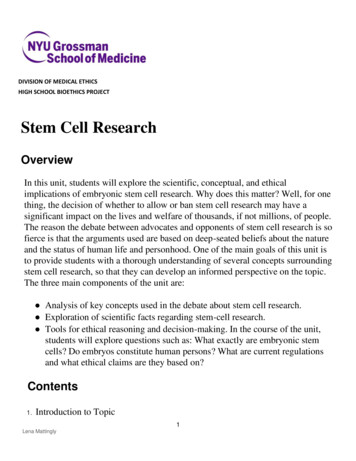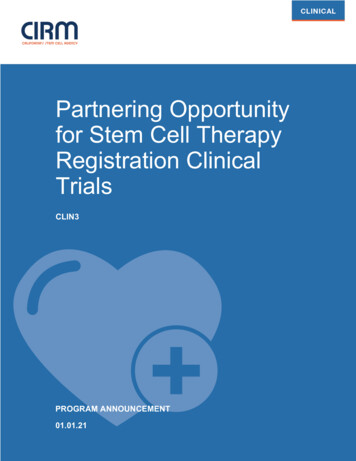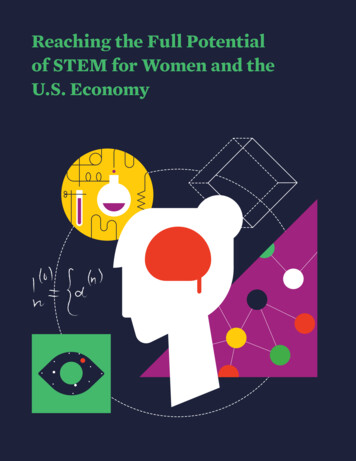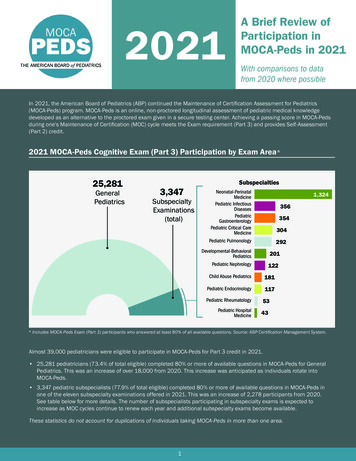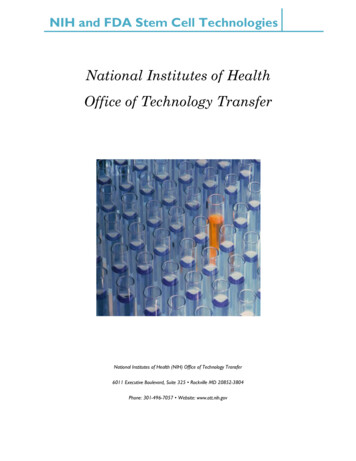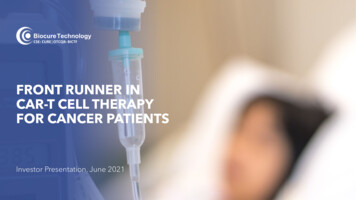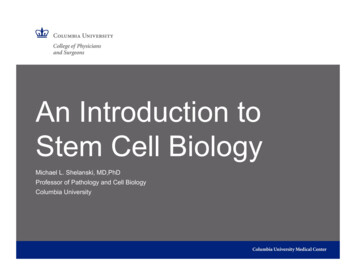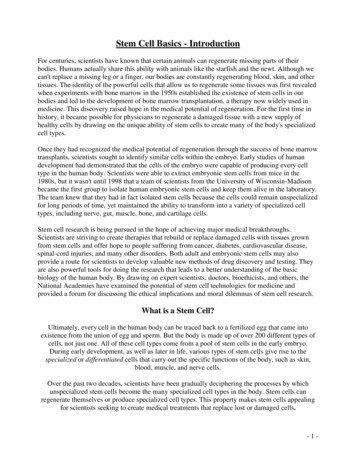
Transcription
Stem Cell Therapy InPediatric NeurologicalDisorders
2Stem Cell Therapy In Pediatric Neurological Disorders
Stem Cell Therapy In Pediatric Neurological DisordersStem Cell Therapy InPediatric Neurological DisordersAuthor :Dr. Alok Sharma,M.S., M.Ch.(Neurosurgeon)Co-Authors :Dr. Nandini Gokulchandran, M.D. (Regenerative Medicine Consultant)Dr. Hemangi Sane, M.D. (USA) (Consultant Medical Physician)Dr. Prerna Badhe, MD (Consultant Neuropathologist)Scientific and Research Co-ordinator :Ms. Pooja Kulkarni, M.Sc. (Biotechnology)3
4Stem Cell Therapy In Pediatric Neurological DisordersStem Cell TherapyIn Pediatric Neurological Disorders 2014 by NeuroGen Brain and Spine Institute Pvt. Ltd.All rights reserved.This book is protected by copyright. No part of this book may be reproduced in anyform by any means, including photocopying, or utilized by any information storageand retrieval system without written permission from the copyright owner, exceptfor the brief quotations embodied in critical articles and reviews.This book is basically a compilation of information / literature on the available on thetopic, from various sources (which have been acknowledged duly). However, this isby no means an exhaustive resource, since the field is evolving at a very rapid pace.Every effort is made to ensure accuracy of material, but the publisher, printer andauthor will not be held responsible for any inadvertent error(s).Coverpage byJohn JuliusPrinted bySurekha Press,A-20, Shalimar Industrial Estate,MatungaLabour Camp, Mumbai 400 019.Tel.: 2409 3877, 2404 3877
Stem Cell Therapy In Pediatric Neurological DisordersAcknowledgementDr. V. C. Jacob, B.Sc., DPT, M.I.A.P.Deputy Director and Head of Neurorehabilitation,NeuroGen Brain and Spine Institute, Navi MumbaiDr. Hema Biju, M.O.Th.Consultant Occupational Therapist, NeuroGen Brain and Spine Institute, Navi MumbaiDr. Joji Joseph, B.P.T., F.C.R.Consultant Physiotherapist, NeuroGen Brain and Spine Institute, Navi MumbaiDr. Hema Sriram, D.A., M.D., D.N.B.Consultant Anaesthesiologist, NeuroGen Brain and Spine Institute, Navi MumbaiDr. Richa Bansod, M.B.B.S, MSHead Surgical Services and Hospital Administration,NeuroGen Brain and Spine Institute, Navi MumbaiMs. Akshata Shetty, M.A.Clinical Psychologist, NeuroGen Brain and Spine Institute, Navi MumbaiDr. Khushboo Bhagawanani, B.P.Th., MIAP, CBE (USA)Physiotherapist, NeuroGen Brain and Spine Institute, Navi MumbaiDr. Amruta A. Paranjape, BPT, MSc (UK)Physiotherapist, NeuroGen Brain and Spine Institute, Navi MumbaiDr. Sushant Gandhi, M.P.Th (Neuro), M.I.A.P.,Physiotherapist, NeuroGen Brain and Spine Institute, Navi MumbaiDr. Jayanti B. Yadav, M.O. Th (Musculoskeletal Sciences)Occupational Therapist, NeuroGen Brain and Spine Institute, Navi MumbaiDr. Akshaya Nagrulkar, M.O.Th.Occupational Therapist, NeuroGen Brain and Spine Institute, Navi MumbaiMs. Vaishali Ganwir, M.A. (Clinical Psychology)Clinical Psychologist, NeuroGen Brain and Spine Institute, Navi MumbaiMs. Ushma HariaConsulting Nutritionist, NeuroGen Brain and Spine Institute, Navi MumbaiMs. Sanika Gupte, M.A. (Psychology)Clinical Psychologist, NeuroGen Brain and Spine Institute, Navi MumbaiMs. Avantika Patil, M.Sc.Research Associate, NeuroGen Brain and Spine Institute, Navi MumbaiMrs. Vibhuti BhattYoga Consultant, NeuroGen Brain and Spine Institute, Navi MumbaiMs. Farheen Sayed, BA, B.Ed.Speech Therapist, NeuroGen Brain and Spine Institute, Navi Mumbai5
Stem Cell Therapy In Pediatric Neurological Disorders6Stem Cell Therapy"An idea whose time has come"INTERNATIONAL2012John B. GurdonShinya Yamanaka20071990Sir Martin EvansDr. E. ThomasNobel Prize Awarded for Stem Cell Research
Stem Cell Therapy In Pediatric Neurological DisordersStem Cell Therapy"An idea whose time has come"NATIONALPrime Minister Narendra Modi visits the Stem cell Institute of Kyoto UniversityJapan and meets with Nobel Prize winner Professor Yamanaka in September 2014.Pranab Mukherjee's speech at Lok Sabha joint sessionPresident Pranab Mukherjee addressed the joint session of the Lok Sabha atthe Central Hall of Parliament in New Delhi on 9th June 2014.The president shared the Narendra Modi government's agenda for the country.From the economy to the environment, from minorities to terrorism, thePresident announced a series of programmes on a variety of issues facing thecountry."My government recognises the central role of Science and Technology in raising thequality of life. It will encourage and incentivise private sector investments, both domesticand foreign, in science and technology and in high-end research aimed at nurturinginnovation. My government will build world class research centres in the fields ofnanotechnology, material sciences, thorium technology, brain research, stem cells,etc. The government will also establish institutes of Technology for Rural Developmentand a Central University of Himalayan Studies."7
Stem Cell Therapy In Pediatric Neurological Disorders8Stem Cell Therapy"An idea whose time has come"Scientific Publications on PediatricNeurodevelopmental Disorders by the AuthorsA) AUTISM1.Alok Sharma, NandiniGokulchandran, Hemangi Sane, Anjana Nagrajan, AmrutaParanjape, Pooja Kulkarni, Akshata Shetty, Priti Mishra, Mrudula Kali, HemaBiju, Prerna Badhe. Autologous bone marrow mononuclear cell therapy forautism - an open label proof of concept study. Stem cell international. 2013 (2013),Article ID 623875, 13 pages.2.Alok Sharma, NandiniGokulchandran, PrernaBadhe, PoojaKulkarni, Priti Mishra,Akshata Shetty and Hemangi Sane. An Improved Case of Autism as Revealedby PET CT Scan in Patient Transplanted with Autologous Bone Marrow DerivedMononuclear Cells. J Stem Cell Res Ther 2013, 3:23.Alok Sharma, Nandini Gokulchandran, Akshata Shetty, Hemangi Sane, PoojaKulkarni and Prerna Badhe. Autologous Bone Marrow Mononuclear Cells maybe Explored as a Novel. Potential Therapeutic Option for Autism. J Clin CaseRep 2013, 3:74.Alok Sharma, Nandini Gokulchandran, Hemangi Sane, Pooja Kulkarni, NancyThomas, Amruta Paranjape, Prerna Badhe. Intrathecal autologous bone marrowmononuclear cell transplantation in a case of adult autism. Autism open access.2013, 3:25.Alok Sharma, Nandini Gokulchandran, Hemangi Sane, Pradnya Bhovad, HemaBiju,Akshata Shetty, Mrudula Kali and Prerna Badhe, Cell therapy effectsportrayed on positron emission tomography computerized tomography scan ofthe brain serve as a new dimension for autism: A case report. Journal of PaediatricNeurology, (2014) (In Press).6.Sharma A, Gokulchandran N, Shetty A, Kulkarni P, Sane H, Badhe P.Neuropsychiatric Disorder Tackled by Innovative Cell Therapy - A Case Reportin Autism. The Journal Stem Cell Research and Transplantation. 2014 July (InPress)(B) CEREBRAL PALSY1.Alok Sharma, Hemangi Sane, Nandini Gokulchandran, Prerna Badhe, PoojaKulkarni and Amruta Paranjape. Stem Cell Therapy for Cerebral Palsy - A NovelOption. Cerebral Palsy. Challenges for the future. 2014: 217-242.
Stem Cell Therapy In Pediatric Neurological Disorders92.Alok Sharma, Hemangi Sane, Amruta Paranjape, Nandini Gokulchandran, PoojaKulkarni and Anjana Nagrajan, Prerna Badhe. Positron Emission Tomography Computer Tomography scan used as a monitoring tool following cellular therapyin Cerebral Palsy and Mental Retardation - A Case Report. Case Reports inNeurological Medicine. Volume 2013, Article ID 141983, 6 pages3.Dr. Alok Sharma, Ms. Pooja Kulkarni, Dr. Hemangi Sane, Dr. NandiniGokulchandran, Dr. Prerna Badhe, Dr. Mamta Lohia, Dr. Priti Mishra. PositronEmission Tomography - Computed Tomography scan captures the effects ofcellular therapy in a case of cerebral palsy. Journal of clinical case reports. 2012J Clin Case Rep 2:195.4.Alok Sharma, Hemangi Sane, Pooja Kulkarni, Myola D'sa, NandiniGokulchandran, Prerna Badhe. Improved Quality of Life in a Case of CerebralPalsy after bone marrow mononuclear cell transplantation. Cell Journal. 2015;17(2) (In Press)(C) MUSCULAR DYSTROPHY1.Dr. A. Sharma, Ms. P. Kulkarni, Dr. G. Chopra, Dr. N. Gokulchandran, Dr. M.Lohia, Dr. P. Badhe. Autologous Bone Marrow Derived Mononuclear CellTransplantation In Duchenne Muscular Dystrophy-A Case Report. Indian journalof Clinical Practice 2012; 23 (3): 169-722.Alok Sharma, Hemangi Sane, Amruta Paranjape, Khushboo Bhagwanani, NandiniGokulchandran, Prerna Badhe. Autologous bone marrow mononuclear celltransplantation in Duchenne muscular dystrophy - a case report. American journalof case reports (Ahead of Print)(D) MISCELLANEOUS1.Alok Sharma, Nandini Gokulchandran, Guneet Chopra, Pooja Kulkarni, MamtaLohia, Prerna Badhe, V .C. Jacob. Administration of autologous bone marrowderived mononuclear cells in children with incurable neurological disorders andinjury is safe and improves their quality of life. Cell Transplantation, 2012; 21Supp 1: S1-S12.2.Alok Sharma, Guneet Chopra, Nandini Gokulchandran, Mamta Lohia, PoojaKulkarni. Autologous Bone Derived Mononuclear Transplantation in RettSyndrome. Asian Journal of Paediatric Practice. 2011; 15 (1): 22-243.Sharma A, Gokulchandran N, Kulkarni P, Chopra G. Application of autologousbone marrow stem cells in giant axonal neuropathy. Indian J Med Sci 2010; 64 :41-44.Alok Sharma, Hemangi Sane, Amruta Paranjape, Nandini Gokulchandran, MansiTakle, Prerna Badhe, Seizures as an adverse event of cellular therapy in pediatricneurological disorders and its prevention. Journal of Neurological Disorders.2014 2(164), 2.
10Stem Cell Therapy In Pediatric Neurological DisordersChapter on "Stem Cell Therapy for Cerebral Palsy"written from NeuroGen, published in aninternational book- " Cerebral Palsy- Challenges forthe Future" (Publisher- Intech)
Stem Cell Therapy In Pediatric Neurological Disorders11Scientific Publications on Other IncurableNeurological Disorders by the Authors1.Alok Sharma, Hemangi Sane, PrernaBadhe, Nandini Gokulchandran, PoojaKulkarni, Mamta Lohiya, Hema Biju, V.C.Jacob. A Clinical Study Shows Safetyand Efficacy of Autologous Bone Marrow Mononuclear Cell Therapy to ImproveQuality of Life in Muscular Dystrophy Patients. Cell Transplantation. 2013;Vol. 22, Supplement 1, pp. S139-S146.2.Sharma A, Gokulchandran N, Sane H, Badhe P, Kulkarni P, Lohia M, NagrajanA, Thomas N. Detailed analysis of the clinical effects of cell therapy forthoracolumbar spinal cord injury: an original study. Journal ofNeurorestoratology. 2013;1:13-223.Sharma A, Sane H, Gokulchandran N, Kulkarni P, Thomas N, et al. (2013) Roleof Autologous Bone Marrow Mononuclear Cells in Chronic Cervical Spinal CordInjury-A Longterm Follow Up Study. J NeurolDisord 1: 138.4.A. Sharma, P. Badhe, N. Gokulchandran, P. Kulkarni, V.C Jacob, M. Lohia, J.George Joseph, H. Biju, G. Chopra. Administration of Autologous bone marrowstem cells intrathecally in Multiple Sclerosis patients is safe and improves theirquality of life. Indian Journal of clinical Practice. 2011:21(11):622-6255.Alok Sharma, Prerna Badhe, Pooja Kulkarni, Nandini Gokulchandran, GuneetChopra, Mamta Lohia, V.C.Jacob. Autologous Bone marrow Derivedmononuclear cells for the treatment of Spinal Cord Injury. The Journal ofOrthopaedics. 2011; 1(1): 33-366.Alok Sharma, Prerna Badhe, Omshree Shetty, Pooja Vijaygopal, NandiniGokulchandran, V.C. Jacob, Mamta Lohia, Hema Biju, Guneet Chopra.Autologous bone marrow derived stem cells for motor neuron disease withanterior horn cell involvement. Bombay hospital journal. 2011; 53(1): 71- 757.Dr. Suvarna Badhe, Ms. Pooja Kulkarni, Dr. Guneet Chopra, Dr. NandiniGokulchandran, Dr. Alok Sharma Dystrophin Deletion mutation pattern andCardiac involvement in 46 cases of Dystrophinopathies. Asian journal of clinicalcardiology. Asian Journal of Clinical Cardiology, Vol. 15, No. 6, October 2012:211-2148.Dr. Alok Sharma, Dr. Hemangi Sane, Dr. Prerna Badhe, Ms. Pooja Kulkarni, Dr.Guneet Chopra, Dr. Mamta Lohia, Dr. Nandini Gokulchandran. AutologousBone Marrow Stem Cell Therapy shows functional improvement in hemorrhagicstroke – a case study. Indian Journal of Clinical Practice, 2012:23(2):100-1059.Alok Sharma, Prerna Badhe, Nandini Gokulchandran, Pooja Kulkarni, HemangiSane, Mamta Lohia, VineetAvhad. Autologous bone marrow derived
12Stem Cell Therapy In Pediatric Neurological Disordersmononuclear cell therapy for vascular dementia – Case report. Journal of stemcell research and therapy. J Stem Cell Res Ther 2:129.10. Alok Sharma, Amruta Paranjape, Hemangi Sane, Khushboo Bhagawanani,Nandini Gokulchandran, and Prerna Badhe. Cellular Transplantation Alters theDisease Progression in Becker’s Muscular Dystrophy. Case Reports inTransplantation. Volume 2013, Article ID 909328, 7 pages11. A. Sharma, P. Kulkarni, N. Gokulchandran, P. Badhe, V. C. Jacob, M. Lohia,J. George Joseph, H. Biju, G. Chopra. Adult Stem Cells for Spinal MuscularAtrophy. Bangladesh Journal Of Neuroscience. 2009; 25(2): 104-10712. Alok Sharma, Hemangi Sane, Anjana Nagrajan, et al. Autologous Bone MarrowMononuclear Cells in Ischemic Cerebrovascular Accident Paves Way forNeurorestoration: A Case Report, Case Reports in Medicine, vol. 2014, ArticleID 530239, 5 pages, 2014. doi:10.1155/2014/53023913. Sharma A., Sane, H., Paranjape, A., Badhe, P., Gokulchandran, N., & Jacob V.(2013). Effect of Cellular Therapy seen on Musculoskeletal Magnetic ResonanceImaging in a Case of Becker’s Muscular Dystrophy.Journal of Case Reports,3(2), 440-447.14. Alok Sharma, Hemangi Sane, Nandini Gokulchandran, Dipti Khopkar, AmrutaParanjape, Jyothi Sundaram, Sushant Gandhi and Prerna Badhe Autologous BoneMarrow Mononuclear Cells Intrathecal Transplantation in Chronic Stroke. StrokeResearch and Treatment, Volume 2014, pages 1-915. Alok Sharma, Hemangi Sane, Dipti Khopkar, Nandini Gokulchandran, HemaBiju, V C Jacob, Prerna Badhe. Cellular therapy targeting Functional outcome ina case of Cervical Spinal Cord Injury. Advances in Stem Cells 2014 (In Press)16. Alok Sharma, Hemangi Sane, DiptiKhopkar, NandiniGokulchandran, V. C. Jacob,Joji Joseph, PrernaBadhe. Functional recovery in chronic stage of spinal cordinjury by Neurorestorative Approach. Case Reports in Surgery 2014 (In Press)
Stem Cell Therapy In Pediatric Neurological Disorders13PrefaceThere are some medical disorders that have remained very difficult to treat over thelast many years. Pediatric neurological disorders like autism, cerebral palsy andmuscular dystrophy have been some of them. All the advances in imaging,pharmacology and surgical techniques failed to make a significant dent in the qualityof lives of these children. However in the recent few years there has been adevelopment in the field of regenerative medicine whereby stem cell therapy hasbecome available to us as a new treatment method . The biggest impact of stem celltherapy has been on the otherwise incurable pediatric neurological disorders. Theseare new and exciting times for pediatric neurology. With increasing research in thisfield and greater publications coming out showing the safety and efficacy of stem celltherapy, a quantum shift is happening in our approach to these disorders . We haveshifted from hopelessness to hope and from lack of options to the availability ofmultiple options in all aspects of their care. We can safely say now that "Stem celltherapy is an idea whose time has come"Despite this there is a lack of awareness about stem cell therapy and the clinicalconditions it could possibly benefit. We have therefore written this book forpediatricians since they are the primary caregivers to all the children with pediatricneurological disorders. Nowadays with availability of information on the internet,parents of these children obtain a lot of knowledge about newer treatment optionsand then ask their doctors about it. It's important that pediatricians understand allaspects of this new therapy so that they can counsel and advise the parentsappropriately. In this book we share with our pediatric colleagues general informationabout what stem cell therapy is, the indications where it can be used, a relevantreview of literature as well as our own clinical results. We hope that with this bookwe are able to bring some clarity about different aspects of stem cell therapy inpediatric neurological disorders. From our own clinical experience we can now saywith reasonable confidence to the parents of these children that with the availabilityof stem cell therapy for your children now : "Aache din aane wale hain".– Dr. Alok Sharma
Stem Cell Therapy In Pediatric Neurological Disorders14Contents1.Introduction .152.What are stem cells? .173.How is stem therapy done? .234.How do stem cells work? .315.Stem Cell Therapy in Autism .436.Stem Cell Therapy in Cerebral Palsy .537.Stem Cell Therapy in Intellectual disability .638.Stem Cell Therapy in Muscular Dystrophy .679.Stem Cell Therapy in Spinal cord injury .7710.How Rehabilitation augments the benefits of stem cell therapy?8711.What are the complications of stem cell therapy? .9512.Ethics involved for stem cell therapy .101Index .106
Stem Cell Therapy In Pediatric Neurological Disorders151. IntroductionNeurodevelopmental and other neurological disorders represent one of the leadingcauses of disability in children throughout the world. These disorders are currentlyestimated to affect as many as a billion people worldwide and the number is expectedto increase considerably in years to come. Very few of these conditions have a cureand they may worsen over time. These children demonstrate a range of symptomsand functional limitations affecting their daily activities. Neurological conditions alsopose an economic burden to the society. Hence, finding a treatment/ cure for thesedisorders is a goal of increasing urgency.The devastating nature of neurological disorders is attributed to the longstandingbelief that the cells of the brain and central nervous system (CNS) are incapable ofregeneration.In 1928, Ramon Y Cajal stated in his work Degeneration & Regeneration ofthe nervous system that "In adult centres the nerve paths are something fixed,ended, immutable. Everything may die, nothing may be regenerated. It isfor the science of the future to change, if possible, this harsh decree."However, recent progress in regenerative medicine has provided hope that injuredCNS can be repaired using stem cells.Stem cells are unspecialized cells with a capacity of self renewal and differentiationinto specialized cells. The main aim of stem cell therapy is axonal regeneration,replacement of damaged neural cells and recovery of lost neural functions. Thesecells either carry out regeneration of new cells or stimulate the endogenous stemcells to reverse the CNS damage. A number of stem and progenitor cell types havebeen proposed as therapy for neurological diseases. These include bone marrowstem cells, neural stem cells, embryonic stem cells and umbilical cord blood stemcells. Extensive research has been carried out in this field. Researchers have anticipatedthat cell therapy may replace the conventional management strategies presentlyavailable for disorders such cerebral palsy, autism, brain injury, spinal cord injury,etc in children.Stem cell therapy has already been translated from bench to bedside. To make itmore efficacious some unsolved queries need to be answered such as the ideal sourceof cells, potent type of cells, optimal route of administration, effective therapeutic
16Stem Cell Therapy In Pediatric Neurological Disorderstime window and identification of the respondent group of patients. In this book wehave made an attempt to address these queries. We have described in detail themechanism of stem cell therapy in various pediatric neurological disorders.
Stem Cell Therapy In Pediatric Neurological Disorders172. What are Stem Cells?Stem cells are defined as undifferentiated cells which are capable of proliferation,self maintenance, production of a large number of differentiated, functional progeny,regenerating tissue after injury and flexibility in the use of these options. These cellsexhibit a unique property of "plasticity" where in cells isolated from one tissue convertto cells of different tissues by crossing lineage barriers and adopting the expressionprofile and phenotype of cells that are unique to other tissues.Types of Stem CellsStem cells are categorized based on their potential to differentiate into other types ofcells.1.Totipotent cells: These cells have the ability to differentiate into all possible celltypes of the human body including extraembryonic and placental cells.2.Pluripotent cells: These cells have ability to differentiate into any of the threegerm layers viz. endoderm, mesoderm and ectoderm.3.Multipotent cells: These cells have the ability to differentiate into specializedcells.Figure 1: Classification of Stem cells
18Stem Cell Therapy In Pediatric Neurological DisordersFigure 2: Differentiation of stem cells4.Oligopotent cells: These cells have the ability to differentiate into a few cells.5.Unipotent cells: These cells have the ability to produce cells only of their owntype, but are capable of self-renewal to be classified as a stem cell.Stem cells are broadly classified based on their origin, as follows:1.Embryonic stem cells (ESCs): These cells are pluripotent cells derived from a 47 day old blastocyst stage embryo. The cells are harvested from the inner cellmass (ICM) of the blastocyst. They can be indefinitely maintained and expandedas pure populations of undifferentiated cells, in culture. Inspite of their clinicalpotential in tissue repair, these cells have triggered various ethical and moralissues as they involve destruction of human embryos. They also have tumorigenicside effects as ESCs and tumor cells share cellular and molecular phenotypessuch as rapid proliferation rate, lack of contact inhibition, a susceptibility togenomic instability, high activity of telomerase, high expression of oncogenesand epigenetic status amongst others. They form teratomas which have thepotential to degenerate into malignant teratocarcinomas. The likelihood ofdevelopment of tumors in children cannot be overlooked as they have manyyears of life ahead of them for the tumor formation to occur. According to theICMR, use of these cells fall into the restricted category.2.Fetal Stem Cells: These cells are isolated either from the aborted fetus or fromthe extra embryonic structures of the fetal origin such as the amniotic fluid andplacenta. Fetal blood is a rich source of haemopoietic stem cells (HSC). Nonhaemopoietic mesenchymal stem cells (MSC) are also found in the First trimesterfetal blood. These cells have better homing capacity, greater multipotentialityand differentiation potential and lower immunogenicity as compared to the adult
Stem Cell Therapy In Pediatric Neurological Disorders19stem cells. Although these cells have a greater therapeutic potential they arealso susceptible to infections. Studies have demonstrated that these cells areprone to KS-associated herpesvirus (KSHV) infections. As the safety is not yetsubstantiated, fetal cells are not often used for transplantation. According tothe ICMR, use of these cells fall into the restricted category.3.Umbilical cord stem cells: Umbilical cord contains a heterogeneous mixture ofstem / progenitor cells at different lineage commitment stages. Cells are isolatedeither from the cord blood or the Wharton jelly. They consist of embryonic stemcell-like and other pluripotential stem cells, which can give rise to hematopoietic,epithelial, endothelial, and neural tissues. Various banks have evolved to collectand preserve the umbilical cord blood. But the utility of these centers is stillquestionable. The protocols and guidelines for collection and retrieval of cellsare still being standardized. Other disadvantages of use of UCBCs are that thetime for platelet engraftment is prolonged in the transplantation of cord blooddue to insufficient cell dose. According to the ICMR, use of these cells fall intothe permitted category.4.Induced pluripotent stem cells (iPSC) : To circumvent the ethical issues involvedin the use of embryonic stem cells, pluripotent cells were generated directlyfrom the patients' own cells. Induced pluripotent stem cells are non-pluripotentadult cells (somatic cells) which have been genetically reprogrammed to formpluripotent cells. But, to initiate the clinical trials involving iPSCs, thereprogramming efficiency and safety has yet to be established.According to theICMR, use of these cells fall into the restricted category.Figure 3: Induced pluripotent stem cells (iPSC)
20Stem Cell Therapy In Pediatric Neurological Disorders5.Adult stem cells: These cells are multipotent stem cells, isolated from adulttissues. They include hematopoietic stem cells, bone marrow derived stem cells,adipose tissue-derived stem cells, neural stem cells amongst others. Adult stemcells are found in almost all the tissues of the body and help to maintain andrepair organs and tissues throughout a person's life. These cells are majorlyderived from the bone marrow, brain, skeletal muscle, liver, pancreas, fat, skinand skeletal muscle. According to the ICMR, use of these cells fall into thepermitted category.Major sources of adult stem cellsBone marrow: Anterior or posterior superior iliac crest is the preferred site for thebone marrow aspiration. If bone marrow cannot be obtained from the iliac crest dueto positioning difficulties or obesity, sternum may be used in adults. However,aspiration from sternum poses a great risk of complications.Bone marrow is a proficient source of autologous cells with distinct regenerativeproperties, which can be quickly harvested and are thus applicable for both chronicand acute diseases. It is the only known organ in which two or more separate anddistinct stem cells and dependent tissue systems not only coexist but functionallycooperate. The mononuclear cell fraction derived from the bone marrow is aheterogeneous population containing differentially matured B-cells, T-cells andmonocytes, as well as rare progenitor cells such as hematopoietic stem cells (HSC),mesenchymal stromal cells (MSC), endothelial progenitor cells (EPC) and very smallembryonic-like cells (VSEL). The hematopoietic cells are the blood cells which giverise to the myeloid (monocytes and macrophages, neutrophils, basophils, eosinophils,erythrocytes, megakaryocytes/platelets, dendritic cells), and lymphoid lineages (Tcells, B-cells, NK-cells). Bone marrow mesenchymal stem cells (BMMSCs) give rise tomesodermal lineage cells such as osteoblasts, chondrocytes, adipocytes, and musclecells along with neuroectodermal cells. It has been observed that use of cell mixtureis more efficacious than individual subfractionated cells of the bone marrow. Theypromote angiogenesis, mediate vascularrepair, and express several cytoprotectivegrowth factors and cytokines. These cellsare also safe and due to its easy availabilitythey are most preferred for cellulartherapy. These cells are used for thetreatment of various neurologicaldisorders such as autism, cerebral palsy,stroke, Parkinson's, Spinal cord injury, etcalong with diabetes, orthopedicconditions, cancers and wound healing.Adipose tissue: Adipose tissue derivedFigure 4: Bone marrow stem cells transforminginto neuron like cells.
Stem Cell Therapy In Pediatric Neurological Disorders21stem cells (ASCs) are multipotent cells, found abundantly in fat tissue. They candifferentiate into several lineages, including adipose cells, chondrocytes, osteoblasts,neuronal cells, endothelial cells, and cardiomyocytes. These cells are obtained eitherthrough liposuction or lipectomy. Mesenchymal stem cells make up the majority ofthe adipose derived stem cells. Due to their plasticity, they are a preferred alternativeto the BMSCs. One of the major disadvantages of adipose derived stem cell is thatthey are not a completely homogeneous cell population in addition to complicatedisolating process. Therefore, an expert is required for cell isolation.Dental pulp: A population of stem cells has been isolated from the human dentalpulp known as dental pulp stem cells (DPSCs). They have an ability to regenerate adentin-pulp-like tissue. DPSCs are a heterogeneous population of cells as they arecomposed of both mesenchymal and ectodermic cells. These cells are readily obtained(from milk teeth, routine dental procedures such as removal of impacted third molars)and have been shown to possess properties similar to neural stem cells andmesenchymal stem cells. Under appropriate conditions, these cells also undergoneuronal differentiation. One of the disadvantages of DPSCs is that it takes longer toculture mesenchymal stem cells from teeth active tissue. Also, it is difficult to harvesta large quantity of stem cells from teeth.References1.Potten CS, Loeffler M. Stem cells: attributes, cycles, spirals, pitfalls anduncertainties. Lessons for and from the crypt. Development. 1990 Dec;110(4):1001-20.2.Lakshmipathy U, Verfaillie C. Stem cell plasticity. Blood Rev. 2005 Jan;19(1):29-38.3.Evans, M. and Kaufman, M. 1981. Establishment in cultureof pluripotent cellsfrom mouse embryos. Nature 292: 154-156.4.De Wert, Guido, and Christine Mummery. Human embryonic stem cells: research,ethics and policy. Human reproduction 18.4 (2003): 672-682.5.Ben-David U,
and Efficacy of Autologous Bone Marrow Mononuclear Cell Therapy to Improve Quality of Life in Muscular Dystrophy Patients. Cell Transplantation. 2013; Vol. 22, Supplement 1, pp. S139-S146. 2. Sharma A, Gokulchandran N, Sane H, Badhe P, Kulkarni P, Lohia M, Nagrajan A, Thomas N. Detailed analysis of the clinical effects of cell therapy for
